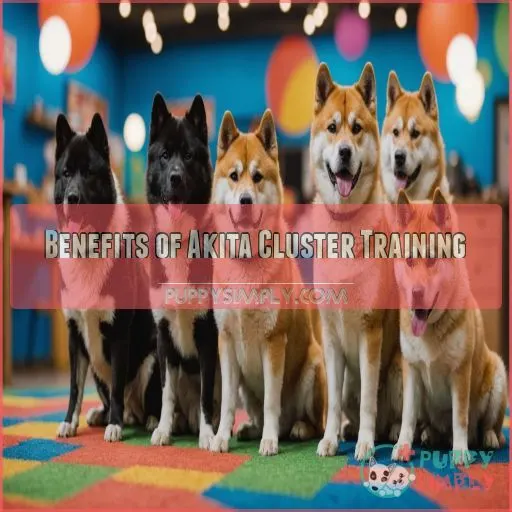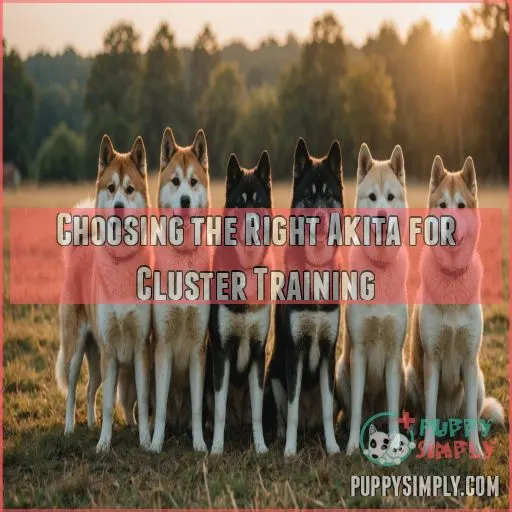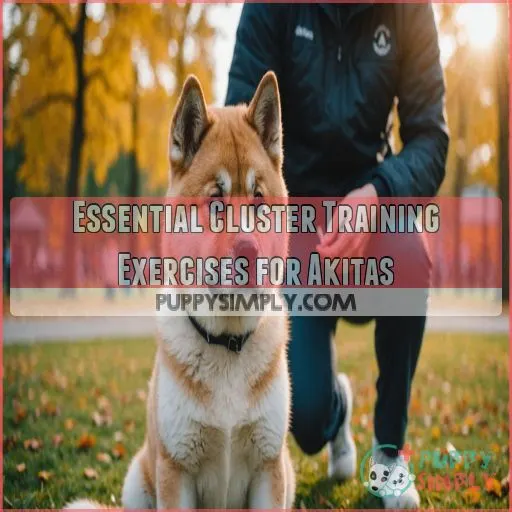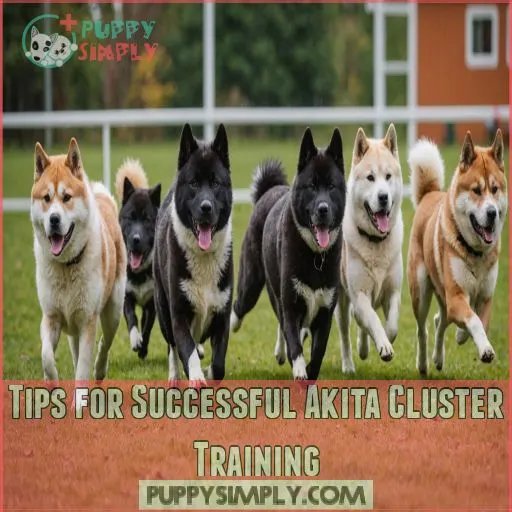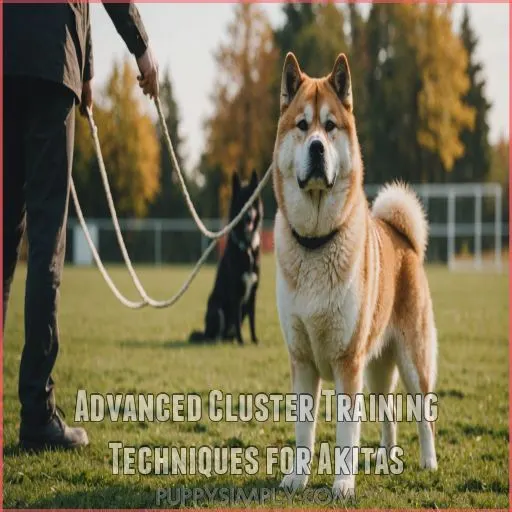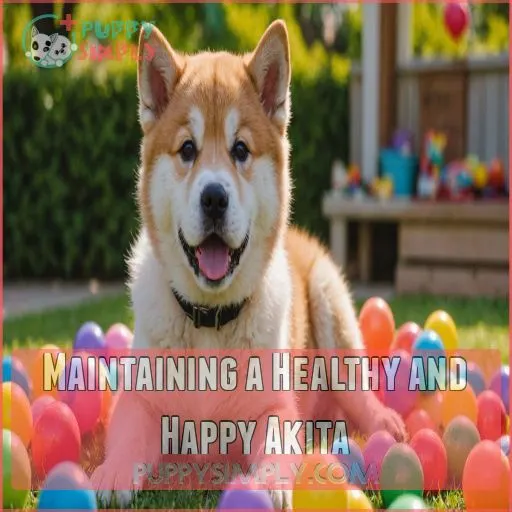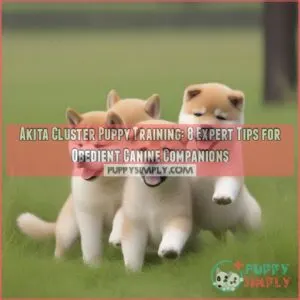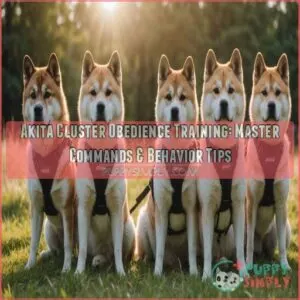This site is supported by our readers. We may earn a commission, at no cost to you, if you purchase through links.
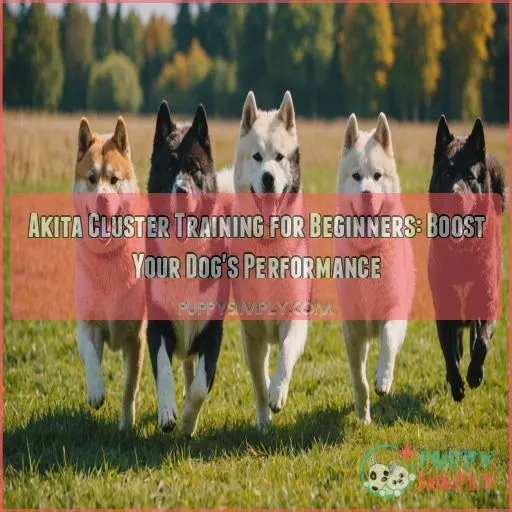
You’ll turbocharge your pup’s strength, agility, and endurance by breaking exercises into short, intense bursts. Don’t worry, you won’t need a gym membership for Fido.
Start with basic obedience, then gradually introduce cluster sets of squats, lunges, and puppy pull-ups (yes, that’s a thing!). Remember, consistency is key, and positive reinforcement is your secret weapon. With patience and the right approach, you’ll have your Akita strutting like a canine Olympian in no time.
Table Of Contents
- Key Takeaways
- Benefits of Akita Cluster Training
- Choosing the Right Akita for Cluster Training
- Building a Strong Foundation
- Understanding Akita Behavior and Psychology
- Designing an Effective Cluster Training Program
- Essential Cluster Training Exercises for Akitas
- Tips for Successful Akita Cluster Training
- Overcoming Common Challenges and Plateaus
- Advanced Cluster Training Techniques for Akitas
- Maintaining a Healthy and Happy Akita
- Frequently Asked Questions (FAQs)
- Conclusion
Key Takeaways
- Embrace the powerhouse within your Akita by using cluster training to boost their strength and agility. Break exercises into short, intense bursts, such as puppy pull-ups and squats – no gym membership needed. Consistency and rewards keep your pup on track without turning training into a tug-of-war.
- Watch your Akita become the Usain Bolt of the dog park. With cluster training, you’ll leave their muscles buzzing and recovery optimized. Rely on effective rest techniques, nutrition, and hydration to keep your athlete’s endurance at its peak.
- Don’t let your Akita’s thick fur knock them out of the game. Choose a training approach tailored to their age and independence. Akitas can be stubborn, so a dash of positive reinforcement turns resistance into cooperation – even if it feels like commanding a king.
- Cluster training turns into a dynamic duo act if you master communication with your Akita. Keep it engaging with clear commands and rewards, allowing flexibility for their mood. Adapt like a dance partner – one with paws and a tail plotting their next move.
Benefits of Akita Cluster Training
Ever wondered how to tap into your Akita’s hidden athletic potential? With cluster training, you’ll boost their power and endurance while making those dog park races a win every time!
Improved Power Expression
Power and precision—what every Akita enthusiast dreams of. By adopting cluster training, you can reach your Akita’s true potential through improved power expression.
Imagine your Akita with:
- Enhanced strength
- Peak muscle recovery
- Effective rest-pause techniques
- Superior barbell displacement
- Best velocity-based training
Get ready to transform your Akita into a powerhouse, one cluster set at a time!
Enhanced Athletic Performance
Cluster training takes your Akita’s athletic performance to new heights.
By manipulating rest periods, you’ll maximize their true power potential.
Say goodbye to plateaus and hello to personal bests.
Your Akita will move with explosive speed and grace, leaving the competition in the dust.
Get ready to help your Akita reach their full potential as an athlete!
Increased Strength and Endurance
Increased strength and endurance go hand-in-hand to help your Akita excel!
You’ll see remarkable strength gains and energy boosts with the right training schedule.
Akita cluster training techniques like cluster triples or block power snatches build barbell discipline and speed, all while keeping Sparky injury-free.
Don’t forget Akita nutrition plays a key role in sustaining their newfound vigor!
Better Muscle Recovery
After an intense Akita cluster training session, muscle recovery is key to keeping your Akita Inu or American Akita at their best. Boost their recovery with these tips:
- Nutrition Impact: Feed them a balanced diet.
- Sleep Importance: Make sure they get enough rest.
- Hydration Tips: Keep them well-hydrated.
Reduced Injury Risk
Ready to jump into preventing injuries? Mastering Akita cluster training is like wearing a superhero cape—empowering your Akita to sidestep potential mishaps. Pay attention to Akita anatomy, warm-up routines, and proper form.
Here’s a quick guide:
| Exercise Frequency | Injury Prevention | Competitive Phase |
|---|---|---|
| Weekly | Stretching | Tapering |
| Bi-weekly | Massage | Monitoring |
| Monthly | Check-ups | Evaluation |
Stay strong, and let’s conquer safer training!
Choosing the Right Akita for Cluster Training
Choosing the right Akita for cluster training is really important. Consider your pup’s age, breed characteristics, temperament, and overall health to make sure you have a successful training experience.
Age and Maturity Considerations
Choosing the right Akita for cluster training hinges on age and maturity.
Take a closer look at these factors for a well-adjusted pup:
- Akita Puppy Training: Start while they’re young; puppies soak up like sponges.
- Adolescent Akitas: Energetic and headstrong – channel focus wisely.
- Senior Akitas: Gentle exercise keeps them sharp without overdoing it.
Betcha they’ll thank you, in their own doggy way!
Breed Characteristics and Temperament
How does an Akita’s personality shape your training approach? These proud dogs have a mind of their own and can be as stubborn as a mule. Understanding Akita behavior is key—embrace their independence, but guide them with gentle, consistent training.
Socialization is essential; without it, their natural dominance can become a runaway train, complicating Akita training efforts.
Health and Fitness Level
Your Akita’s fitness level is important for effective cluster training.
Imagine this: a sprightly pup ready to conquer the world!
Exercise routines should match their age and joint health, like adjusting a suit to fit.
Consider a balanced diet to fuel their energy.
Building a Strong Foundation
Before you get started with Akita cluster training, it’s important to build a strong foundation.
Start by mastering basic obedience commands, socializing your pup, and establishing a consistent training routine.
This will set the stage for a successful and rewarding cluster training journey.
Basic Obedience Commands
Teaching your Akita basic obedience commands is like building a solid house on firm ground.
These commands lay the foundation for a well-mannered pup.
Don’t let their stubborn streak fool you; with patience, even the most regal Akita will follow:
- Sit
- Stay
- Come
- Heel
- Down
Embrace this journey, and watch them thrive!
Socialization and Desensitization
Now that you’ve nailed basic obedience commands, it’s time for socialization and desensitization.
Take your pup on adventures, so they get positive exposure to new experiences.
Think of it as their way of collecting unforgettable postcards.
Early socialization helps reduce fear, turning your Akita into a confident explorer.
Establishing a Training Routine
Consistency is key when setting up a training routine.
Think of it as crafting the perfect recipe for success: Timing, Duration, Frequency, and Intensity are your main ingredients.
Like baking a cake, too much of one thing can spoil the batch.
Schedule regular sessions—akin to morning coffee—to keep you and your Akita on the right track.
Understanding Akita Behavior and Psychology
As an Akita owner, you’ll quickly learn that these dogs march to the beat of their own drum.
While they’re incredibly loyal and affectionate with their families, Akitas can also be stubborn, independent, and challenging to train due to their strong-willed nature.
Understanding your Akita’s unique personality and communication style is key to designing an effective cluster training program that brings out the best in your canine athlete.
Stubbornness and Independence
Akitas have a reputation for stubbornness and independence; addressing these challenges takes patience. Your furry friend might act like a king on a throne, but don’t fret!
- Use positive reinforcement techniques.
- Be consistent in your commands.
- Break tasks into small, dear-sized pieces.
- Tap into their motivation.
- Stay firm as a loving, level-headed leader.
Embrace the journey!
Loyalty and Affection
Imagine this: your Akita, loyal as a shadow, builds unbreakable family ties—its protective instincts making it the ultimate guardian.
This breed’s love language involves sticking to you like glue, offering companionship beyond measure.
Embrace their devotion with understanding, and remember, a little affection goes a long way. You’re the center of their universe, and that’s a bond worth nurturing!
Energy Levels and Motivation
After exploring their loyalty and affection, let’s shift gears and tackle their energy and motivation.
To keep your Akita’s fire burning during training, set clear, ambitious goals.
Make it fun! Think of training as a lively dance — it should challenge them, yet also let them shine.
Communication and Feedback
Effective communication with your Akita is key – pay close attention to their body language, vocal cues, and subtle signals.
Respond with positive reinforcement and consistent training to build a strong bond.
Your Akita will thrive on your clear guidance and unwavering support.
With patience and understanding, you’ll discover their full potential.
Designing an Effective Cluster Training Program
Designing an effective cluster training program for your Akita might sound complex, but with the right goals and objectives, you can create a fun and rewarding experience.
Just like crafting the perfect sandwich, where each layer builds on the one before, you’ll set up a periodized plan with cluster sets to boost your dog’s performance and energy.
Setting Goals and Objectives
To design an effective training plan, first clarify your Akita’s goals. Are you aiming for better focus or enhanced endurance?
Define clear cluster targets and performance metrics.
Keep an eye on progress tracking like a hawk spotting its prey.
Creating a Periodized Training Plan
Creating a periodized training plan for your Akita is key to reaching their potential.
Start by identifying training phases that align with your dog’s goals.
Sprinkle in some exercise variety to keep things lively.
Don’t forget rest periods—your Akita needs downtime too!
Incorporating Cluster Sets and Reps
Crafting the perfect cluster set routine for your Akita takes some trial and error.
Start with simple variations like cluster sets of 3-5 reps, with 10-30 seconds of rest between each cluster.
Experiment with different rep ranges and rest intervals to find what ignites your pup’s power and keeps them engaged.
Just be sure to monitor for signs of fatigue or strain.
Progressive Overload and Intensity
You’ve got the reins now! When upping the ante with progressive overload, start by tweaking your Akita’s training frequency and rest periods.
Incrementally increase weight progression and intensity metrics to keep things challenging.
Mix in exercise variety; like adding a pinch of spice to a recipe, it keeps your Akita engaged and motivated.
Just remember, slow and steady wins the race!
Essential Cluster Training Exercises for Akitas
In "Essential Cluster Training Exercises for Akitas," you’ll learn how to incorporate cluster training to enhance your Akita’s strength and endurance through squats, lunges, and more.
Let’s transform your Akita into a strong, healthy athlete while having fun together.
Squats and Lunges
When training your Akita with squats and lunges, make sure you use proper technique for safety. These exercises boost your dog’s muscle engagement and alert Akita form.
- Engage those muscles: Feel the burn, but stop when needed.
- Safety first: Use a non-slip surface.
- Break it down: Start slow, build momentum.
- Treats work wonders: Reward effort, not perfection.
Deadlifts and Leg Press
As you progress with your Akita’s cluster training, deadlifts and leg presses are essential exercises to include.
Focus on proper form to avoid injury, and gradually increase the weight as your pup gets stronger.
Remember to adjust the rep and set schemes to match their unique needs and abilities.
Mastering these moves will take your Akita’s performance to new heights!
Bench Press and Incline Press
Shifting from deadlifts to bench press variations lets your Akita develop chest strength.
Focus on proper Akita form with these exercises—think of it as their power pose!
Explore incline press benefits by gradually adjusting height, improving strength and posture.
Grip techniques matter; start light for safe weight progression.
Pull-ups and Rows
Pull-ups and rows aren’t just for bodybuilders—your Akita can benefit too!
Strengthen your dog’s grip strength with a bit of creativity.
Try variations to keep it exciting.
Focus on proper form to prevent injury.
Progress gradually with a solid plan, and you’ll see results.
Tips for Successful Akita Cluster Training
Starting cluster training with your Akita might feel like herding cats, but consistency and your canine’s favorite treats work wonders.
Keep instructions clear and adapt your approach if needed, and soon you’ll convince even a stubborn Akita that training’s really just a game.
Consistency and Patience
Consistency and patience are key when training your Akita for cluster workouts.
It may take time for your pup to get the hang of it, but stick with it – the payoff will be worth it.
Remember:
- Embrace the journey, not just the destination.
- Celebrate small wins along the way.
- Adjust your approach if needed, but don’t give up.
Positive Reinforcement and Reward
Gotten your Akita to pay attention long enough? Bribe them with treats! Praise, toys, or extra playtime work wonders too. Akitas love being showered with attention.
Positive reinforcement transforms your stubborn furry friend into a loyal companion. It’s like opening a new door to their potential.
They’re not just wagging tails; they’re plotting their next conquest—perhaps just your heart (or the treat on it).
Clear Communication and Feedback
After rewarding your Akita with treats, understanding their body language strengthens the owner-dog bond.
Remember, they can’t read minds, but they sure can read vibes faster than you can say ‘good boy!’
Use consistent commands and clear communication. Whether it’s a nod or a thumbs up, positive reinforcement helps your Akita embrace training techniques with a wagging tail.
Adaptability and Flexibility
Akita training isn’t one-size-fits-all, especially with cluster training. When programs need tweaking, owner flexibility is key. It’s like dancing, where you adapt to the beat—here to your Akita’s temperament.
- Adjust routines based on mood
- Modify intensity with changing energy levels
- Tailor exercise plans to specific needs
- Be ready for sudden behavior shifts
- Embrace creativity in training sessions
Overcoming Common Challenges and Plateaus
Cluster training your Akita can be rewarding, but you’ll likely face some hurdles along the way.
Let’s tackle common challenges like stubbornness, fluctuating motivation, and training plateaus to keep your furry friend on track and thriving in their performance journey.
Addressing Stubbornness and Resistance
You’ve mastered the basics, but now your Akita’s stubborn streak is showing. Don’t fret! This challenge is your chance to flex your training muscles. Let’s tackle that resistance head-on with some clever strategies:
| Stubborn Behavior | Your Power Move |
|---|---|
| Ignoring commands | Be the treat wizard |
| Pulling on leash | Channel inner tree |
| Refusing new tricks | Break it down, boss |
| "Selective hearing" | Become irresistible |
Managing Energy Levels and Motivation
While stubbornness can be a challenge, keeping your Akita motivated is key to successful cluster training.
Managing their energy levels and motivation requires a personalized approach.
Here’s how to keep your furry friend engaged:
- Mix up training routines to prevent boredom
- Use high-value rewards for extra motivation
- Incorporate play sessions between cluster sets
- Adjust training intensity based on your Akita’s energy level
Preventing Injury and Burnout
Ever wondered how to keep your Akita safe during cluster training?
Preventing injury and burnout is really important.
Don’t skimp on rest and recovery – they’re your dog’s secret weapons.
Proper nutrition and hydration are non-negotiable.
Always warm up before intense sessions.
By balancing hard work with smart recovery, you’ll build a powerhouse pooch that’s ready to tackle any challenge.
Adjusting Training Programs and Goals
When your Akita hits a training wall, it’s time to shake things up.
Reassess your goals and tweak your program accordingly.
Are you pushing too hard or not enough?
Consider introducing new exercises or changing the intensity of cluster sets.
By fine-tuning your approach, you’ll keep your Akita engaged and on track for success.
It’s all about finding that sweet spot between challenge and enjoyment.
Advanced Cluster Training Techniques for Akitas
You’ve mastered the basics of cluster training with your Akita, and now it’s time to take things up a notch.
These advanced techniques will challenge your furry friend and push them to their full athletic potential, turning your loyal companion into a canine powerhouse.
Incorporating Plyometrics and Agility
Now that you’ve conquered those plateaus, let’s kick things up a notch! Plyometrics and agility training can take your Akita’s performance to new heights. These explosive exercises will have your furry friend leaping like a kangaroo and darting like a cheetah.
Here’s how to get started:
- Start with low-impact exercises to build strength
- Gradually increase jump height and complexity
- Mix in agility drills for mental stimulation
- Always prioritize safety and proper form
Using Resistance Bands and Weights
With resistance bands and weights, you’ll take your Akita’s cluster training to new heights.
Choose bands that match your dog’s strength and size, keeping in mind those Akita weight limits.
Start light and progress gradually to prevent injuries.
Focus on proper form – it’s the key to helping your furry friend reach his full potential.
Your Akita’s wagging tail will thank you for the extra muscle-building challenge.
Increasing Intensity and Volume
You’ve mastered resistance bands and weights with your Akita. Ready to kick it up a notch? Let’s ramp up the intensity and volume of your cluster training.
Progressive overload is key here – gradually increase the weight or reps in each set.
Tweak your rest protocols too; shorter breaks between clusters will challenge your pup’s endurance.
Periodizing Training for Competition
Ready to take your Akita’s training to the next level? Periodizing for competition is your ticket to peak performance.
Break your training into phases: off-season, pre-competition, and competition.
Tailor cluster sets to each phase, gradually ramping up intensity.
Don’t forget recovery strategies – they’re your secret weapon.
By fine-tuning your Akita’s training schedule, you’ll have a champion-level companion who’s always ready to shine in the spotlight.
Maintaining a Healthy and Happy Akita
You’ve mastered cluster training with your Akita, but that’s just part of keeping your furry friend in top shape.
Let’s explore how proper nutrition, regular exercise, mental stimulation, and veterinary care work together to maintain your Akita’s health and happiness.
Nutrition and Diet Considerations
Now that you’ve mastered advanced cluster training, let’s talk about fueling your Akita’s performance.
Proper nutrition is key to keeping your furry powerhouse in top shape.
Think of your Akita as a high-performance engine – it needs the right fuel to run smoothly.
Here’s what to keep in mind:
- Fresh, lean proteins to build muscle
- Complex carbs for sustained energy
- Omega-3s for joint health
- Antioxidant-rich fruits and veggies for recovery
Exercise and Physical Activity
While proper nutrition fuels your Akita’s body, exercise keeps it running smoothly.
Akitas aren’t high-energy dogs, but they still need regular activity to stay healthy and happy.
A daily walk or two, mixed with some playtime, will keep your furry friend in tip-top shape.
Tailor your dog’s exercise routine to their age and fitness level for best results.
Mental Stimulation and Engagement
Beyond physical exercise, your Akita’s mind craves stimulation.
Keep that clever canine brain sharp with:
- Challenging puzzle toys
- Scent work games
- Obedience training sessions
- Interactive play with you
These activities tap into your Akita’s natural intelligence and problem-solving skills.
Plus, they’re a great way to bond with your furry friend. Remember, a mentally engaged Akita is a happy Akita – and less likely to find mischievous ways to entertain themselves!
Regular Veterinary Check-ups and Care
Regular check-ups are the backbone of your Akita’s health.
You’ll want to keep up with their vaccine schedule and parasite prevention to ward off potential threats.
Don’t forget about dental care – a sparkling smile isn’t just for show!
As your furry friend ages, senior care becomes essential.
Frequently Asked Questions (FAQs)
How does Akita coat affect cluster training?
Your Akita’s thick, double coat can impact cluster training.
Expect more rest between sets to manage fatigue from all that shedding.
Stay on top of brushing to reduce hair buildup during intense workouts.
Are there age restrictions for Akita cluster training?
About 70% of an Akita’s energy comes when it’s cool.
Start cluster training once your Akita reaches physical maturity, around 18 months.
Before then, focus on basic obedience and bonding, as patience and guidance are key.
Can Akitas be cluster trained with other dogs?
If you’re thinking of cluster training Akitas alongside other dogs, caution is key.
Akitas can be fiercely independent and protective, so make sure you socialize them properly and supervise them to avoid turning that training session into a reality TV showdown!
What equipment is necessary for Akita cluster training?
Did you know Akitas can weigh 100 pounds?
For cluster training a big dog like that, sturdy leashes, durable toys, and healthy treats are essential.
Keep it light-hearted and reward every win, you’ll be the alpha!
How often should Akitas participate in cluster training?
You’ll want to incorporate Akita cluster training 2-3 times per week, allowing ample recovery time in between sessions.
This balanced approach helps your pup build strength and stamina without overdoing it.
Consistency is key for great results!
Conclusion
Imagine your Akita as the next canine Hercules, bounding with unparalleled strength and agility!
That dream can become a reality with Akita cluster training for beginners.
By focusing on short, intense workouts and consistency, you’ll create a powerhouse pup.
As you progress, adapting to your Akita’s needs makes sure you both enjoy the journey.
So, grab those treats, get moving, and watch your Akita transform into a superstar athlete!

